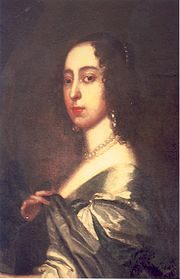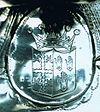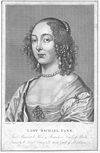
Henry Bourchier, 5th Earl of Bath
Encyclopedia

Biography
Sir Henry Bourchier was probably born and was certainly brought up in Ireland. He was the fifth son of the Sir George BourchierGeorge Bourchier
Sir George Bourchier English soldier who fought and settled in Ireland. Member of the Privy Council of Ireland, Member of the Irish Parliament.-Biography:George Bourchier was a the third son of the 2nd Earl of Bath by his wife Eleanor...
(d.1605) and English soldier who settled in Ireland, and Martha (c1555-1598), daughter of William, 1st Lord Howard of Effingham
William Howard, 1st Baron Howard of Effingham
William Howard, 1st Baron Howard of Effingham , was the eldest son of Thomas Howard, 2nd Duke of Norfolk by his second wife, Agnes Tilney...
. Hence the Lord High Admiral Charles Lord Howard of Effingham
Charles Howard, 1st Earl of Nottingham
Charles Howard, 1st Earl of Nottingham , known as Howard of Effingham, was an English statesman and Lord High Admiral under Elizabeth I and James I...
was an uncle.
Henry entered Trinity College Dublin, which his father had helped found, in c1597. (BA in 1605; Fellow in 1606; MA in 1610). The 21st fellow of the college, he was one of only eight in the first thirty years of the college's life who remained a layman.
Henry's three of his four elder brothers died young and the fourth one, Sir John Bourchier, Kt, (knighted 24 March 1610/11), of the manor of Clare, co. Armagh
County Armagh
-History:Ancient Armagh was the territory of the Ulaid before the fourth century AD. It was ruled by the Red Branch, whose capital was Emain Macha near Armagh. The site, and subsequently the city, were named after the goddess Macha...
, died 25 March 1614 having been MP for county Armagh, 1613-14. By 1614, therefore, Henry had inherited in Ireland from both his father and brother over 18000 acres (72.8 km²), and then when he became 5th Earl of Bath, on the death of his cousin the 4th Earl
Edward Bourchier, 4th Earl of Bath
Edward Bourchier, 4th Earl of Bath , was born 27 Aug 1575 in Somerset to William Bourchier, 3rd Earl of Bath and Elizabeth Russell. Edward was married twice first on 14 July 1623 to Dorothy St John, daughter of Oliver St John, 3rd Baron St John of Bletso and Dorothy Read. They had five children...
aged 47 in March 1636/37, he could add Tawstock
Tawstock
Tawstock is a village and civil parish in North Devon in the English county of Devon. It has a population of 2,093.-Parish Church:St Peter's church is, unusually for Devon, a church largely of the 14th century. The plan is cruciform and the site is in the former park of the Earls of Bath...
and 36 manors in Devon and Somerset to his name.
Henry was knighted 9 November 1621. He joined the Privy Council on 8 August 1641, and in 1643 he was put in the Tower of London
Tower of London
Her Majesty's Royal Palace and Fortress, more commonly known as the Tower of London, is a historic castle on the north bank of the River Thames in central London, England. It lies within the London Borough of Tower Hamlets, separated from the eastern edge of the City of London by the open space...
. He was released, appointed Commissioner for the Defense of Oxford, 1644, and in the same year, 22 January, (Royalist
Royalist
A royalist supports a particular monarch as head of state for a particular kingdom, or of a particular dynastic claim. In the abstract, this position is royalism. It is distinct from monarchism, which advocates a monarchical system of government, but not necessarily a particular monarch...
) Lord Privy Seal
Lord Privy Seal
The Lord Privy Seal is the fifth of the Great Officers of State in the United Kingdom, ranking beneath the Lord President of the Council and above the Lord Great Chamberlain. The office is one of the traditional sinecure offices of state...
in the Oxford Parliament
Oxford Parliament (1644)
The Oxford Parliament was the Parliament assembled by King Charles I for the first time 22 January 1644 and adjourned for the last time on 10 March 1645, with the purpose of instrumenting the Royalist war campaign.Charles was advised by Edward Hyde and others not to dissolve the Long Parliament as...
. He remained Lord Privy Seal, his maternal grandfather (Lord Howard of Effingham) had held the post 1572-73, until his death at Tawstock, on 16 August 1654. He was buried there the next day.
Henry lived at Bath House, 53/54 Lincoln's Inn Fields
Lincoln's Inn Fields
Lincoln's Inn Fields is the largest public square in London, UK. It was laid out in the 1630s under the initiative of the speculative builder and contractor William Newton, "the first in a long series of entrepreneurs who took a hand in developing London", as Sir Nikolaus Pevsner observes...
(from 1640); otherwise at Tawstock, North Devon; Clare Castle, near Tandragee, co. Armagh; at Bourchier Castle, Lough Gur
Lough Gur
Lough Gur is a lake in County Limerick, Ireland between the towns of Herbertstown and Bruff. The lake forms a horseshoe shape at the base of Knockadoon Hill and some rugged elevated countryside. It is one of Ireland's most important archaeological sites...
, near Bruff, Limerick. Bourchier Castle was a tower house, originally built by the Desmonds
Earl of Desmond
The title of Earl of Desmond has been held historically by lords in Ireland, first as a title outside of the peerage system and later as part of the Peerage of Ireland....
(FitzGerald
FitzGerald
The surname FitzGerald is a translation of the French-Norman fils de Gérald, or son of Gerald . Variant spellings include Fitz-Gerald and the modern Fitzgerald. The name can also be used as two separate words Fitz Gerald...
s). It still stands, though Clare Castle, 'a stoney house or castle of lime', a 100 by 80 feet (24.4 m) fortified house, is a ruin.
Family

Francis Fane, 1st Earl of Westmorland
Francis Fane, 1st Earl of Westmorland, KB head of the Fane family, of Mereworth in Kent, and then of Apethorpe in Northamptonshire, was first a Member of Parliament and then an English peer...
and his wife Mary. They married in the Mildmay family church, St. Bartholomew the Great, Smithfield, and at the time of the marriage she was aged 25 and he c50.

Estates
The county LimerickLimerick
Limerick is the third largest city in the Republic of Ireland, and the principal city of County Limerick and Ireland's Mid-West Region. It is the fifth most populous city in all of Ireland. When taking the extra-municipal suburbs into account, Limerick is the third largest conurbation in the...
estate was of 12800 acres (51.8 km²) (English acres) featuring the manors of Lough Gur
Lough Gur
Lough Gur is a lake in County Limerick, Ireland between the towns of Herbertstown and Bruff. The lake forms a horseshoe shape at the base of Knockadoon Hill and some rugged elevated countryside. It is one of Ireland's most important archaeological sites...
and Glenogra, in the Barony of the Small County in County Limerick, Munster, had been granted by letters patent or grant of Elizabeth I (E.I. 30) on 2 November 1589 to his father Sir George. (The property spilled over into county Tipperary
County Tipperary
County Tipperary is a county of Ireland. It is located in the province of Munster and is named after the town of Tipperary. The area of the county does not have a single local authority; local government is split between two authorities. In North Tipperary, part of the Mid-West Region, local...
).
In c1718 this consisted of :
The manor of Loughguyre & Glenogre, 5 castles, 300 Messuages, 1500 cottages, 400 Tofts, 8 Mills,
1600 Gardens, 2500 acres (10.1 km²) of land, 1300 acres (5.3 km²) of Meadow, 3600 acres (14.6 km²) of Pasture, 500 acres (2 km²) of Wood & underwood,
300 acres (1.2 km²) of Furze & Heath & 200 acre (0.809372 km²) other.
Most of the estate in Armagh, at least 6000 acres (24.3 km²), lying between Tandragee and Portadown
Portadown
Portadown is a town in County Armagh, Northern Ireland. The town sits on the River Bann in the north of the county, about 23 miles south-west of Belfast...
, was granted to Bath's elder brother John (died 1614) by a patent of James I (J.I.8) on 30 November 1610. Bath acquired more land in county Armagh from Sir Francis Cook on 23 July 1646. Part of the Armagh estate, Brackagh Bog, under two miles (3 km) south of Portadown, is today a Nature and Moss Reserve. Other lands in both Limerick and Armagh were sold to them or once belonged to Sir William Leger
William St Leger
-Life:He was a grandson of Anthony St Leger. He took part in the Flight of the Earls in 1607, when Hugh O'Neill, Earl of Tyrone, and Rory O'Donnell, 1st Earl of Tyrconnell, together with more than ninety of their family and followers, the chief of the Gaelic and Catholic resistance in Ireland, fled...
(1586–1642) as shown by a Deep Poll, dated 17 July 1619.
On Bath's death the Irish estates passed to his widow, and from her to her nephew Sir Henry Fane
Sir Henry Fane
Sir Henry Fane KB, JP was the only son and heir of George Fane of Hatton Garden, by his wife Dorothy daughter and heir of James Horsey of Honnington, Warwickshire....
, KB, (1650-1705/6), then to his son Charles, who, on the strength of this inheritance, was created Viscount Fane and Baron Loughguyre, both in the peerage of Ireland, in 1718, and thence by descent to c.1979. The lesser entailed English estate in Devon, centered around Tawstock, passed elsewhere, to the Wrey
Wrey Baronets
The Wrey Baronetcy, of Trebitch in the County of Cornwall, is a title in the Baronetage of England. It was created on 30 June 1628 for William Wrey, the member of an ancient Devon family. The third Baronet was a supporter of the Royalist cause and sat as Member of Parliament for Lostwithiel after...
family, as a result of their descent from the daughter of the 3rd Earl of Bath.
At the time of its partition between the heirs of the last Viscount Fane
Charles Fane, 2nd Viscount Fane
Charles Fane, 2nd Viscount Fane was a landowner in Ireland and England, a Whig Member of Parliament and the British Resident in Florence.-Early life:...
; Peter de Salis
Peter, 3rd Count de Salis
Peter de Salis, Count of the Holy Roman Empire Peter de Salis, Count of the Holy Roman Empire (Nobile Signor Don Pietro Podesta di Salis) Peter de Salis, Count of the Holy Roman Empire (Nobile Signor Don Pietro Podesta di Salis) (28 June 1738, parish of St. James, Westminster -...
and Lord Sandwich
John Montagu, 5th Earl of Sandwich
John Montagu, 5th Earl of Sandwich PC , styled Viscount Hinchingbrooke until in 1792, was a British peer and Tory politician.-Background and education:...
in 1805 the Bourchier/Fane Irish estate comprised 6620 acres (26.8 km²) in county Limerick (with gross annual rental value of £4,189), and 6908 acres (28 km²) in county Armagh (worth £2,671 pa).
In 1883 the de Salis part of the divided Bourchier estate in Ireland was listed in Bateman's
Bateman's 'Great Landowners' (1883)
John Bateman FRGS published the fourth edition of his The Great Landowners of Great Britain and Ireland, A list of all owners of Three thousand acres and upwards, worth £3,000 a year; Also, one thousand three hundred owners of Two thousand acres and upwards, in England, Scotland, Ireland, & Wales,...
Great Landowners, Return of Owners of Land, as consisting of 3663 acres (14.8 km²), (worth £5,392 per annum), in County Armagh and 4026 acres (16.3 km²), (worth £3,349 per annum), in County Limerick.
Wife

-
- (Devon Household Accounts 1627-59 Part II, Devon and Cornwall Record Society, 1996):
- June 1640 paid Mr Gelthrope [George Geldorp, c1595-1665] for the Lady Peterbrough'sWilliam Howard, 3rd Baron Howard of EffinghamWilliam Howard, 3rd Baron Howard of Effingham was an English nobleman, the eldest son of Charles Howard, 1st Earl of Nottingham and Katherine Carey, Lady of the chamber to Queen Elizabeth who died 25 Feb 1603 at Arundel House, Strand, Middlesex, ENG.As Sir...
picture 12 0 0 (Gray, p. 174), [she was Lord Bath's cousin]; - between 29 May and 4 June 1641 to Sir Anthony Vandick in part for my picture 20 0 0 (Gray, p. 238);
- between 4 June and 14 June 1641 to Sir Anthony Vandick for my picture 10 0 0; for the frame 4 0 0; to his man 1 0 0 (Gray, p. 238), [Van Dyck died 9 December 1641];
- November 1641 paid LewisPeter LelySir Peter Lely was a painter of Dutch origin, whose career was nearly all spent in England, where he became the dominant portrait painter to the court.-Life:...
[Peter Lely, 1618–1680, who arrived in England April 1641] the 6th of Novem. for a copy of my own Dick to the ... [illegible] 18s (Gray, p. 241); - cJanuary 1642/43 To Lewie [Lely] the painter in further part of his bill of £15 5s 0 (Gray p. 116);
- cMarch to Lewie the painter in further part of his bill 5 0 0 (Gray, p. 116);
- May [?] 1646 Lewis the painter is to have £8 for 2 pieces & 18s for one frame & £5 for a copy drawn by him of my picture (Gray, p. 190);
- September - March 1646/47 to Mr Gildropp by bill 01 18 00 (Gray, p. 131).
The vicar of Shiplake
Shiplake
Shiplake is a village and civil parish about south of Henley-on-Thames in Oxfordshire, England on the River Thames.-History:The Church of England parish church of St. Peter and St. Paul dates from at least the 13th century, but in 1869 the Gothic Revival architect G.E. Street rebuilt the chancel,...
the Rev. James Granger
James Granger
James Granger was an English clergyman, biographer, and print collector. He is now known as the author of the Biographical History of England from Egbert the Great to the Revolution .-Life:...
(1723–1776) in his A Biographical History of England, from Egbert the Great to the Revolution (1769) describes, (on page 78 of volume 4 of the fifth edition, 1824), the Lombart engraving of the Van Dyck portrait of ' RACHAEL MIDDLESEXIAE comitissa ':
- 'Rachel, daughter of Francis Fane, the first earl of Westmoreland. She was first married to Henry Bourchier, earl of Bath; secondly, to Lionel Cranfield, the third earl of Middlesex, who succeeded his brother James in 1651. Lionel died without issue by her, Oct. 26, 1674. I have seen her picture at BasildenLower BasildonLower Basildon is a small village in the civil parish of Basildon, near to Pangbourne, in the English county of Berkshire. It is the location of the parish church of St Bartholomew. The National Trust property, Basildon Park, is just above it....
, in Berkshire [near Granger's Shiplake], among the ancestors of the late Lord Viscount FaneSir Henry FaneSir Henry Fane KB, JP was the only son and heir of George Fane of Hatton Garden, by his wife Dorothy daughter and heir of James Horsey of Honnington, Warwickshire....
. She is said to have left a very large sum to build a private chapel; but the money was never applied to the use for which it was intended. Lord FaneCharles Fane, 2nd Viscount FaneCharles Fane, 2nd Viscount Fane was a landowner in Ireland and England, a Whig Member of Parliament and the British Resident in Florence.-Early life:...
used to speak of her as a very good woman. Her portrait was painted by Vandyck, in the reign of Charles I. The print should have been inscribed, " Lady Rachel Fane, or Rachel Countess of Bath." Anachronisms of this kind are too common upon portraits.'
Oswald Barron
Oswald Barron
Arthur Oswald Barron , always known as Oswald Barron, was a journalist and scholar on heraldic and genealogical subjects....
, writing in 1905 and 1906, described her: 'She was a great lady and a busybody, and her cloud of kinsfolk held her in fear as their patroness and suzerain', '... a masterful woman, she lived feared and respected by her numerous kindred whom she advanced by her interest at court' .

